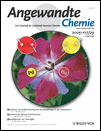Titelbild: Palladiumkatalysierte Kreuzkupplungen in der Totalsynthese / Metathesereaktionen in der Totalsynthese (Angew. Chem. 29/2005)
Abstract
Zwei leistungsfähige Synthesemethoden haben die organische Synthese vorangebracht wie kaum eine andere Entwicklung. In zwei Aufsätzen auf S. 4516 und 4564 ff. illustrieren K. C. Nicolaou et al., wie Metathesereaktionen und palladiumkatalysierte Kreuzkupplungen zu überragenden Methoden zum Aufbau von Kohlenstoff-Kohlenstoff-Bindungen in der Totalsynthese von Naturstoffen gereift sind.




